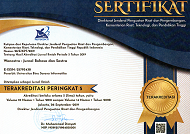Measuring English Language Education Department Students’ Speaking Fluency Level
Abstract
This research aimed at investigating English Language Education department students’ speaking fluency level. The research subjects were twelve third-semester students of English Language Education Department at the University of Muhammadiyah Malang. Mixed method was used in this research. The data were collected in the form of audio transcription. Three fluency standards were used, namely speech rate, pause rate, and disfluent syllable. The result showed that all of the students obtained the disfluent syllable, with a score below 30 disfluencies per minute. The majority of students obtained a low level of speaking fluency in terms of speech rate and pause rate. The average of students’ speech rate was below 162 syllables per minute and the majority of students’ pause rate was above 1 second. In conclusion, two students achieved level 3 (good) of speaking fluency and ten other students achieved level 2 (intermediate).
Key Word: English language education students, fluency level, speaking
Full Text:
PDFReferences
Ano, K. (2005). Fluency and accuracy in the spoken English of Japanese high school learners. Journal of Japan – Korea Association of Applied Linguistic, 9 – 16..
Ary, D., Jacobs, L. C., Sorensen, C., & Razavieh, A. (2010). Introduction to research in education. Belmont: Wadsworth.
Brougthon, G. et al. (2003). Teaching English as a Foreign Language. New York: Routledge.
Brown, H. D. (2004). Language assessment: principles and classroom practices. New York: Pearson Education.
Campione, E., & Véronis, J. (2002). A Large-Scale Multilingual Study of Silent Pause Duration. ISCA Archive, 1-4.
Creswell, J. W. (2012). Fourth Edition: Educational Research; Planning,Conducting and Evaluating Quantitative and Qualitative Research. Boston: Pearson.
Haidara, Y. (2016). Psychological factor affecting English speaking performance for the English learners in Indonesia. Universal Journal of Educational Research. 4.,(7): 1501-1505. Mali: University of Bamako, Mali.
Harmer, J. (2007). The Practice of English Language Teaching. Harlow: Pearson Longman.
Heldner, M., Edlund, J. (2010). Pauses , gaps and overlaps in conversations. Journal of Phonetics, 38(4):555-568.
Hidayat, B. (2018). An Analysis of Students’ Speaking Fluency of English Language Education Department at Fourth Semester of University of Muhammadiyah Malang. Unpublished Thesis. University of Muhammadiyah Malang.
Jong, N. De., Hulstijn, J. (2009). Relating ratings of fluency to temporal and lexical aspects of speech. (June).
Karimy, S., Piskhar, K. (2017). The Relationship Among Students’ Speaking Accuracy and Fluency and Teachers’ Oral Skill Class Presentation. Journal of Applied Linguistic and Language Research, 4,(2), 47 – 56.
Kormos, J., & Dénes, M. (2004). Dénes, M. (2004). Exploring measures and perceptions of fluency in the speech of second language learners. Budapest: Eötvös Loránd University, Budapest.
Lennon, P. (1990). ‘Investigating fluency in EFL: a quantitative approach’. Language Learning, 40: 387-417
Luoma, S. (2004). Assessing Speaking. Cambridge: Cambridge University Press.
Nation, I. S. P., & Newton, J. (2009). Teaching ESL/EFL listening and speaking (T. and Francis, Ed.). Routledge.
Redeka, S. C. (2017). An Analysis of Students’ Speaking Fluency of International Relations Students at Sixth Semester of University Muhammadiyah Malang. Unpublished Thesis. University of Muhammadiyah Malang.
Stockdale, D. A. (2009). Comparing Perception of Oral Fluency to Objective Measures in the EFL Classroom (Unpublished Thesis). Birmingham: University of Birmingham..
Tennessee Department of Education Fluency Resource Packet. (2009). Assessment of Speech : Determination of Speech Impairment : Fluency.
Yarus, J. S. (1998). Real-Time Analysis of Speech Fluency: Procedures and Reliability Training.
DOI: https://doi.org/10.31294/w.v13i1.9812
Copyright (c) 2021 Sendi Winaryo, Rosalin Ismayoeng Gusdian

This work is licensed under a Creative Commons Attribution-ShareAlike 4.0 International License.
Index by:
Published by Department of Research and Community Service (LPPM) Universitas Bina Sarana Informatika by supported Relawan Jurnal Indonesia
Jl. Kramat Raya No.98, Kwitang, Kec. Senen, Jakarta Pusat, DKI Jakarta 10450

This work is licensed under a Creative Commons Attribution-ShareAlike 4.0 International License






